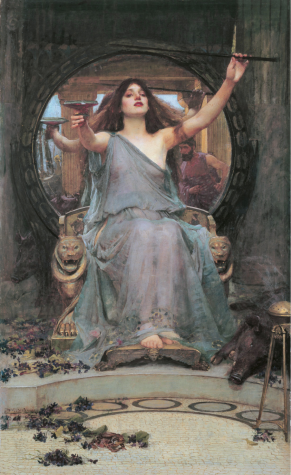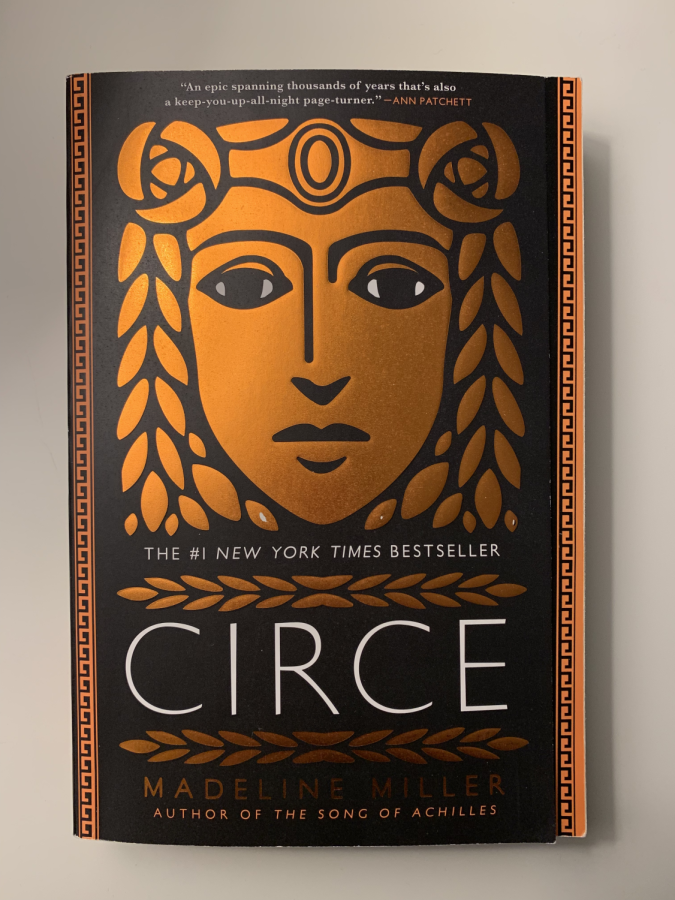Madeline Miller’s “Circe”: Simply Magical
March 20, 2022
Many people are familiar with Homer’s “The Odyssey,” a legendary epic describing the trials and triumphs of the strong and witty Odysseus as he voyages home from Troy. But in the 2018 novel “Circe,” Madeline Miller spins the tale of one of its secondary characters as a heroine in her own right. With poetry-like cadence, the life of the abandoned witch-goddess is finally revealed; Miller masterfully illustrates how the ostracized daughter of Helios, the Titan god of the sun, takes advantage of her exile on the island of Aiaia and becomes an unforgettable force in the lives of everyone she encounters.
In a vast family of Titans and nymphs, it seems that timid Circe, the eldest child of raging Helios and beautiful Perse, is out of place. Named after a falcon for her unusually sharp eyes, and repeatedly ostracized by her family, Circe finds solace on a deserted island. Here she raises her youngest brother, Aeëtes, away from her other siblings, the flaunting Pasiphaë and proud Perses. But when Aeëtes leaves her for his stronger ambitions, Circe turns to the mortal Glaucos for comfort. A love triangle ensues between Circe, Glaucos and the captivating Scylla, and Circe turns to the magic of the flowers that grow on the island to exact revenge. After she confesses her misdeed to her father, it is proven by Aeëtes that the magic, “pharmaka,” came not from the flowers, but from the witchcraft in Circe herself.
Incessantly mocked for her uselessness, she finally feels a glimmer of purpose, but her hopes are crushed by her father’s merciless fist. Though this inherent power resides in each of Perse’s children, Circe is banished to the faraway island “Aiaia” for her wrongdoings and also to appease the Olympians in their age-old brawl. The island seems daunting at first, but Circe begins to clasp it strongly within her fist, leading the flora to grow at her touch and the fauna to roam at her side. A son of Zeus, Hermes, visits Circe to tell her of his father’s wrath. Though their relationship throughout the story is turbulent, Hermes stays true to his role as the messenger of the gods and alerts her to every new and potentially dangerous newcomer.
Between her call to Crete to aid her sister in the birth of the legendary Minotaur, and turning visitors with ulterior motives into pigs, Circe uses the centuries of her life to hone and perfect her witchcraft, and to make both Aiaia and mortals do her bidding. No longer bound by Helios’ command, she experiences a euphoric freedom and vigor with each step upon her flourishing island. But when the famous Odysseus arrives, seeking her forgiveness for his fellow soldiers that she had turned into swine, he leaves Circe with something she was never prepared for. Her life is filled with the newfound attachment to the legendary hero, but also shadowed by his firm connection to the unsparing Athena, his mentor. Per oracle, Athena would take her and Odysseus’ son for fear that he would bring a terrible fate upon Odysseus. Through tumultuous years of raising her mortal son, Telegonus, and fending off Athena’s relentless efforts to kill him, Circe summons her strength and establishes her place in the world: Circe, goddess and witch of Aiaia, must bow down to no one.
Though “Circe” has its roots in Homer’s original epic, the narrative difference is astounding. Odysseus in “The Odyssey” is the hero that Circe, as a secondary character, supports for only so much as a chapter. In the original tale, she is portrayed as a vengeful witch with the malicious desire to make her visitors “wholly forget their native land.” When Odysseus comes to the rescue of his comrades and intimidates Circe into defeat, she surrenders to the man and submits to his every desire. “The Odyssey” may have shown Circe crying to the famed hero, “Prince Laërtiadês, Odysseus never at fault!” but Miller’s witty take on the goddess involves quite the opposite.
A stunning feminist piece, “Circe” gives a new definition to the “witch” of Aiaia. Miller writes the heroine as careful and calculated, motivated to take revenge on the men who have wronged her; it can hardly be regarded as a capricious whim when Miller details the trauma and mental strife that the goddess had endured at the hands of those she turned into pigs. What’s more, Miller’s Circe converses with Odysseus’ eldest son, Telemachos, later in the book, only for them to concur about how at-fault the “never baffled Odysseus!” actually was. “All these gods, all these mortals who aided him,” he says to Circe. “Men talk of his wiles. His true talent was in how well he could take from others.”
No longer does the narrative center around one of Greek literature’s most praised heroes; rather, it exposes his weaknesses as a mortal, suggesting that his bravado was merely an inflated hubris. Throughout the stunning novel, Miller continues to break down the myths and legends to reveal the truth about the misunderstood daughter of the Sun, finally bringing justice to the famous goddess’ overlooked origin story.
From millennia-old Greek pottery to 19th-century oil paintings, Circe is repeatedly shown to hold a cup holding poison and a wand with which she performs her “dark magic”.

But is she really as dark and unilateral as common lore portrays her to be? Miller’s work is more than a justification for Circe’s actions: it flips the legend on its head. “Circe” highlights the goddess’s life from the very beginning. We are immediately introduced to her parents, the Titan Helios and the sea nymph Perse who dominate the world of underground deities. Though the eldest of these celestial beings, Circe distinguishes herself from her selfish family from the start, more loving and nurturing than her three younger siblings, including her famous younger sister Pasiphaë. After helping her to give birth to the Minotaur, she regains her standing as an independent force. She notes that, though Pasiphaë was undoubtedly more regal a goddess, she was “twice the witch.” Furthermore, her mortal voice, different from the booming voice of her godly counterparts, is just another part of her that is set apart from them; as she explains to Telemachos, “Gods are ugly things.”
The minute details of her life are divulged, from the tormenting banishment to her unwelcome visitors, building Circe’s character in each walk of her eternal life. In Miller’s stunning take, Circe is no more a weak, submissive being than she is a bitter witch, and she breaks out of the box that old literature and art painted her in so often before.
This breathtaking novel deserves 5 stars for the intricate weaving of humanity through the story of an immortal goddess and the unwavering, bold lines of prose. Miller used every word to her advantage, allowing Circe’s journey from tragedy to self-acceptance to resonate within her readers. Though her claim to fame is her 2011 novel, “The Song of Achilles,” which won the Orange Prize for Fiction, “Circe” undoubtedly raises the bar with a heightened sense of maturity and introspection, an element that makes it an even more mesmerizing retelling of a well-known classic. The fast-paced chapters tie themselves together seamlessly, detailing rapid action scenes and slow, pensive ones in an alluring fashion, leaving readers constantly reaching for the next page.
It is a captivating tale for both those well-versed in ancient Greek lore and those who haven’t yet been introduced into the wild world of Greek mythology. Miller – who taught Latin, Greek, and the work of Shakespeare for 15 years – provides a hefty glossary of famous mythological icons in the back of the book, a perfect section for beginners to reference as they read.
As Leah Greenblatt from Entertainment Weekly so perfectly stated, “Miller, with her academic bona fides and born instinct for storytelling, seamlessly grafts modern concepts of selfhood and independence to her mystical reveries of smoke and silver, nectar and bones.”














